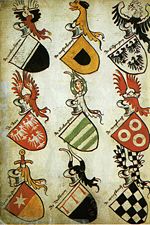Heraldry: Difference between revisions
imported>David Boven (adding hidden headings as starting point) |
imported>Chris Day No edit summary |
||
| Line 1: | Line 1: | ||
{{subpages}} | |||
[[Image:Hyghalmen Roll-Late 1400s.jpg|right|thumb|150px|{{#ifexist:Template:Hyghalmen Roll-Late 1400s.jpg/credit|{{Hyghalmen Roll-Late 1400s.jpg/credit}}<br/>|}}The Hyghalmen Roll of arms contains examples of medieval heraldry.]] | [[Image:Hyghalmen Roll-Late 1400s.jpg|right|thumb|150px|{{#ifexist:Template:Hyghalmen Roll-Late 1400s.jpg/credit|{{Hyghalmen Roll-Late 1400s.jpg/credit}}<br/>|}}The Hyghalmen Roll of arms contains examples of medieval heraldry.]] | ||
Revision as of 02:05, 2 February 2009
Heraldry, in its most general sense, encompasses all matters relating to the duties and responsibilities of officers of arms.[1] To most, though, heraldry is the practice of designing, displaying, describing, and recording coats of arms and badges. Historically, it has been variously described as "the shorthand of history"[2] and "the floral border in the garden of history."[3] The origins of heraldry lie in the need to distinguish participants in combat when their faces were hidden by iron and steel helmets.[4] Eventually a system of rules developed into the modern form of heraldry.
The system of blazoning arms that is used today has been developed by the officers of arms since the dawn of the art. This includes a description of the shield, the crest, and, if present, supporters, mottoes, and other insignia. An understanding of these rules is one of the keys to sound practice of heraldry. The rules do differ from country to country, but there are many aspects that carry over in each jurisdiction.
Though heraldry is nearly 900 years old, it is still very much in use. Many cities and towns in Europe and around the world still make use of arms. Personal heraldry, both legally protected and lawfully assumed, has continued to be used around the world. Heraldic societies thrive to promote understanding of and education about the subject.
References
- ↑ Stephen Friar, Ed. A Dictionary of Heraldry. (Harmony Books, New York: 1987), 183.
- ↑ Arthur Charles Fox-Davies, A Complete Guide to Heraldry, (Thomas Nelson, 1925).
- ↑ Iain Moncreiffe & Don Pottinger, Simple Heraldry (Thomas Nelson, 1953).
- ↑ John Brooke-Little. An Heraldic Alphabet. (Macdonald, London: 1973),2.
